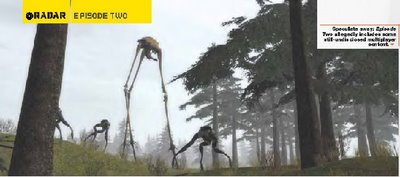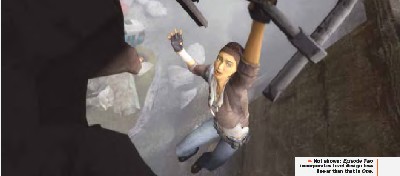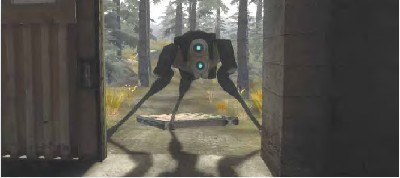Valve spills (and hides) more on the next installment
 game PREVIEW
game PREVIEWLITTLE SURPRISE: PROJECT LEAD
David Speyrer is tightest-lipped about the Episode Two teasers we most want him to talk about. Combine Advisors (those pupaelike pods that ultimately escape the Citadel) are the “host bodies” Dr. Breen refers to, aren’t they? And his brain/mind is now among them, no? Neither hot nor cold. Drop us a hint as to the nature of the Dr. Kleiner’s “secret technological advances,” we say. And is this the same project Mossman refers to from the Arctic? Nada. G-Man’s signature briefcase is missing in the mystery fi gure’s one and only appearance. What gives? Stone-faced again, Speyrer isn’t saying, isn’t insinuating, isn’t even smirking. And perhaps appropriately so, since Half-Life 2’s episodic packets play relatively stingy with anything in the way of real plot developments (better to veil what little is there until later than blow the lid now). We do know this, though: Episode Two introduces one new weapon (the so-called Strider Buster), a single new foe (the tiny tripod Hunter pictured here), and one set of wheels (a self-propelled battering ram). Speyrer, however, is happy to talk around the episode’s
hot-button topics….
CGW: Any design elements introduced in Episode One that you intend to elaborate on in
the second episode? David Speyrer: We think of the episodes as adding tools to our game-design toolbox, so each episode draws from an ever-larger set of gameplay tools and mechanics. It’s cool torealize that so many of the elements that we take for granted today, like the gravity gun or our companion A.I., were risky R&D projects during the development of Half-Life 2 or Episode One. Continuing at that rate as we release more episodes is pretty exciting for us as designers, and for our customers. We’ll bring many elements from Episode One forward into Episode Two, but we expect to use dynamic scripted sequences extensively. They allow close interaction between NPCs during combat—such as Alyx wrestling with zombies in Episode One—and because they happen spontaneously, every player will see different interactions at different moments in the game. We see lots of possibilities for this with respect to Hunters and citizens, for example.
CGW: Granted, you’re still working this out, but what would you say an episodic game needs to do in order to ensure the attractiveness of subsequent installments? Making us care for a character and then setting us up for her seemingly impending death seems like a start….
DS: The main thing we want to do is move the Half-Life story forward meaningfully. We want
our customers to realize that these episodes are the continuation of Half-Life and Half-Life 2
rather than optional detours from the main story line. Character and story are fundamental to the franchise, and we intend to keep pushing on those in every episode. Of course, we’ll always
keep the gameplay fresh and fun by introducing new NPCs, settings, and game mechanics.
CGW: In a previous interview with CGW, Valve managing director Gabe Newell explained that
“in Episode Two, there are areas and vehicles that we saw potential in and wanted to push
forward.” Any chance we’ll commandeer a Hunter, à la Battlestar Galactica’s Cylon Raider?
DS: Sounds cool—I’ll have to watch that episode.
CGW: Episode One continues to establish Alyx as a character, and yet, the more life we see there, the less alive Gordon seems—an autistic weapon whose only actions, as Dr. Breen argues, are destructive. Perhaps part of that stems from the decision to avoid putting words in the player’s mouth or implement a clumsy “give hug” key—does this sort of assessment concern
you going ahead? DS: Having the player be mute is definitely a design constraint that we struggle with at times, but the benefits far outweigh the drawbacks. We worked hard to immerse players in our universe, and hearing Gordon speak would just remind players that they’re playing a game. Despite the design difficulties, we still think that Gordon needs to be an empty vessel for the player’s personality and emotions.
CGW: When we last talked, you dismissed the desire to learn about new weapons and levels as somewhat pedestrian, at least next to meatier matters like motivation. And yet, from the gravity gun to ant lions, headcrabs to snarks, Half-Life’s weapons locker and monster menagerie have helped make the series what it is. Wasn’t Episode One a little light on both?

EPISODE TWO

DS: The gravity gun in HL2 redefined for us the notion of “weapon” in the franchise. So we think that things like flares and saw blades are as important, if not more important, than traditional FPS weapons.
CGW: Valve intensively tracks and iterates in response to tester feedback. We can imagine a
designer groaning at a player’s seeming naiveté in the face of a challenge and cynically deciding
to simply mark out a path or puzzle with a flashing icon—in the way certain other mass-market
titles have—instead of continuing to tweak less obvious cues. How integral to the success of
your games has this philosophy proven?
DS: I can’t imagine shipping a game without putting it through our playtesting process. So
many of our scenarios, especially our puzzles, went through many rounds of catastrophic
failure in playtests. In many cases, there was no way to foresee those failures, much less imagine possible solutions. Because we refine incrementally, we always try the most subtle solution that we think will work and test that before resorting to more heavy-handed solutions. So, yes, I’d say the process is very integral to our games’ success.
GORDON NEEDS TO BE AN EMPTY VESSEL FOR THE PLAYER’S PERSONALITY AND EMOTIONS.”
| روابط هذه التدوينة قابلة للنسخ واللصق | |
| URL | |
| HTML | |
| BBCode | |












